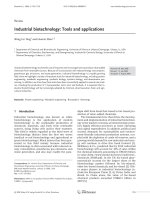Economics principles tools and applications 9th by sullivan sheffrin perez chapter 10
Bạn đang xem bản rút gọn của tài liệu. Xem và tải ngay bản đầy đủ của tài liệu tại đây (2.45 MB, 24 trang )
Economics
NINTH EDITION
Chapter 10
Fiscal Policy
Prepared by Brock Williams
Copyright © 2017, 2015, 2012 Pearson Education, Inc. All Rights Reserved
Learning Objectives
10.1 Explain how fiscal policy works using aggregate demand and aggregate supply.
10.2 Identify the main elements of spending and revenue for the U.S. federal government.
10.3 Discuss the key episodes of active fiscal policy in the U.S. since World War II.
Copyright © 2017, 2015, 2012 Pearson Education, Inc. All Rights Reserved
Fiscal Policy
•
Fiscal policy
Changes in government taxes and spending that affect the level of GDP.
Copyright © 2017, 2015, 2012 Pearson Education, Inc. All Rights Reserved
10.1 THE ROLE OF FISCAL POLICY(1 of 5)
Fiscal Policy and Aggregate Demand
Panel A shows that an increase in government spending shifts
the aggregate demand curve from AD0 to AD1, restoring the
economy to full employment. This is an example of
expansionary policy.
Panel B shows that an increase in taxes shifts the aggregate
demand curve to the left, from AD0 to AD1, restoring the
economy to full employment. This is an example of
contractionary policy.
Copyright © 2017, 2015, 2012 Pearson Education, Inc. All Rights Reserved
10.1 THE ROLE OF FISCAL POLICY(2 of 5)
Fiscal Policy and Aggregate Demand
•
Expansionary policies
Government policy actions that lead to increases in aggregate demand.
•
Contractionary policies
Government policy actions that lead to decreases in aggregate demand.
Copyright © 2017, 2015, 2012 Pearson Education, Inc. All Rights Reserved
10.1 THE ROLE OF FISCAL POLICY(3 of 5)
The Fiscal Multiplier
•
As the government develops policies to stabilize the economy, it needs to take the multiplier into account.
•
The total shift in aggregate demand will be larger than the initial shift. As we will see later in this chapter,
•
U.S. policymakers have taken the multiplier into account as they have developed policies for the economy.
The Limits to Stabilization Policy
•
Stabilization policies
Policy actions taken to move the economy closer to full employment or potential output.
Copyright © 2017, 2015, 2012 Pearson Education, Inc. All Rights Reserved
10.1 THE ROLE OF FISCAL POLICY(4 of 5)
The Limits to Stabilization Policy
LAGS
Panel A shows an example of successful stabilization policy.
The solid line represents the behavior of GDP in the absence of policies. The dashed
line shows the behavior of GDP when policies are in place. Successfully timed
policies help smooth out economic fluctuations.
Panel B shows the consequences of ill-timed policies.
Again, the solid line shows GDP in the absence of policies and the dashed line shows
GDP with policies in place. Notice how ill-timed policies make economic fluctuations
greater.
Copyright © 2017, 2015, 2012 Pearson Education, Inc. All Rights Reserved
10.1 THE ROLE OF FISCAL POLICY(5 of 5)
The Limits to Stabilization Policy
LAGS
•
Inside lags
The time it takes to formulate a policy.
•
Outside lags
The time it takes for the policy to actually work.
FORECASTING UNCERTAINTIES
What makes the problem of lags even worse is that economists are not very accurate in forecasting what will happen in the economy.
Copyright © 2017, 2015, 2012 Pearson Education, Inc. All Rights Reserved
APPLICATION 1
INCREASING LIFE EXPECTANCY AND AGING POPULATIONS
•
SPUR COSTS OF ENTITLEMENT PROGRAMS
APPLYING THE CONCEPTS #1: Why are the United States and many other countries facing dramatically increasing costs for their government
programs?
•
•
Today, Social Security, Medicare, and Medicaid constitute approximately 10 percent of GDP.
Experts estimate that in 2075 spending on these programs will be approximately 22 percent of GDP.
How will our society cope with increased demands for these services?
Possible solutions:
•
•
•
•
Leave the existing programs in place and just raise taxes to pay for them.
The government should save and invest now to increase GDP in the future to reduce the burden on future generations.
Reform the entitlement systems, placing more responsibility on individuals and families for their retirement and well-being.
Reform the health-care system to encourage more competition to reduce health-care expenditures.
Copyright © 2017, 2015, 2012 Pearson Education, Inc. All Rights Reserved
10.2 THE FEDERAL BUDGET (1 of 8)
Federal Spending
Copyright © 2017, 2015, 2012 Pearson Education, Inc. All Rights Reserved
10.2 THE FEDERAL BUDGET (2 of 8)
Federal Spending
•
Discretionary spending
The spending programs that Congress authorizes on an annual basis.
•
Entitlement and mandatory spending
Spending that Congress has authorized by prior law, primarily providing support for individuals.
Copyright © 2017, 2015, 2012 Pearson Education, Inc. All Rights Reserved
10.2 THE FEDERAL BUDGET (3 of 8)
Federal Spending
•
Social Security
A federal government program to provide retirement support and a host of other benefits.
•
Medicare
A federal government health program for the elderly.
•
Medicaid
A federal and state government health program for the poor.
Copyright © 2017, 2015, 2012 Pearson Education, Inc. All Rights Reserved
10.2 THE FEDERAL BUDGET (4 of 8)
Federal Revenues
Copyright © 2017, 2015, 2012 Pearson Education, Inc. All Rights Reserved
10.2 THE FEDERAL BUDGET (5 of 8)
Federal Revenues
SUPPLY-SIDE ECONOMICS AND THE LAFFER CURVE
•
Supply-side economics
A school of thought that emphasizes the role that taxes play in the supply of output in the economy.
•
Laffer curve
A relationship between the tax rates and tax revenues that illustrates that high tax rates could lead to lower tax revenues if economic activity is severely
discouraged.
Copyright © 2017, 2015, 2012 Pearson Education, Inc. All Rights Reserved
10.2 THE FEDERAL BUDGET (6 of 8)
The Federal Deficit and Fiscal Policy
•
Budget deficit
The amount by which government spending exceeds revenues in a given year.
•
Budget surplus
The amount by which government revenues exceed government expenditures in a given year.
Copyright © 2017, 2015, 2012 Pearson Education, Inc. All Rights Reserved
10.2 THE FEDERAL BUDGET (7 of 8)
Automatic Stabilizers
The increased federal budget deficit works through three channels:
1.
Increased transfer payments such as unemployment insurance, food stamps, and other welfare payments increase the income of some households, partly offsetting the
fall in household income.
2.
Other households whose incomes are falling pay less in taxes, which partly offsets the decline in their household income. Because incomes do not fall as much as they
would have in the absence of the deficit, consumption spending does not decline as much.
3.
Because the corporation tax depends on corporate profits and profits fall in a recession, taxes on businesses also fall. Lower corporate taxes help to prevent businesses
from cutting spending as much as they would otherwise during a recession.
•.
Automatic stabilizers
Taxes and transfer payments that stabilize GDP without requiring policymakers to take explicit action.
Copyright © 2017, 2015, 2012 Pearson Education, Inc. All Rights Reserved
10.2 THE FEDERAL BUDGET (8 of 8)
Are Deficits Bad?
•
No – Automatic Stabilizers
•
Yes – Crowding Out
PRINCIPLE OF OPPORTUNITY COST
The opportunity cost of something is what you sacrifice to get it.
Copyright © 2017, 2015, 2012 Pearson Education, Inc. All Rights Reserved
APPLICATION 2
THE CONFUCIUS CURVE?
APPLYING THE CONCEPTS #2: How are tax rates and tax revenues related?
•
While the idea that cutting tax rates might actually increase tax revenue is often attributed to economist Arthur Laffer, in fact, it is actually a much older idea
than that.
•
Yu Juo, one of the twelve wise men who succeeded Confucius in ancient China, was asked what should be done in the case of a famine if the government
had insufficient funds. He replied that the tax rate should be cut to 10 percent. Skeptical government bureaucrats did not have enough funds at a 20
percent rate, so how could they cut it to 10 percent?
•
Yu Juo replied, “Cutting taxes and limiting your expenses allow people to raise their standard of living. Afterwards, you will no longer need to worry about
famine and shortage.”
•
Revenue estimators in Washington, D.C, do not share entirely in Yu Juo’s wisdom, but they do recognize that cutting tax rates will stimulate economic
activity.
Copyright © 2017, 2015, 2012 Pearson Education, Inc. All Rights Reserved
10.3 FISCAL POLICY IN U.S. HISTORY (1 of 4)
The Depression Era
During the 1930s, politicians did not believe in modern fiscal policy, largely because they feared the consequences of government budget deficits. According to
Brown, fiscal policy was expansionary only during two years of the Great Depression, 1931 and 1936.
The Kennedy Administration
Although modern fiscal policy was not deliberately used during the 1930s, the growth in military spending at the onset of World War II in 1941 increased total
demand in the economy and helped pull the economy out of its long decade of poor performance. But to see fiscal policy in action, we need to turn to the
1960s. It was not until the presidency of John F. Kennedy during the early 1960s that modern fiscal policy came to be accepted.
Copyright © 2017, 2015, 2012 Pearson Education, Inc. All Rights Reserved
10.3 FISCAL POLICY IN U.S. HISTORY (2 of 4)
The Vietnam War Era
•
Permanent income
An estimate of a household’s long-run average level of income.
The Reagan Administration
The tax cuts enacted during 1981 at the beginning of the first term of President Ronald Reagan were significant. However, they were not proposed to increase
aggregate demand. Instead, the tax cuts were justified on the basis of improving economic incentives and increasing the supply of output.
Copyright © 2017, 2015, 2012 Pearson Education, Inc. All Rights Reserved
10.3 FISCAL POLICY IN U.S. HISTORY (3 of 4)
The Clinton, George W. Bush, and Obama Administrations
•
At the beginning of his administration, President Bill Clinton proposed a “stimulus pachage” that would increase aggregate demand, but was defeated by
Congress.
•
Later, President Clinton, along with a Republican-controlled Congress, passed a major tax increase to balance the budget and brought the Federal budget
into surplus.
•
In 2001, President George W. Bush passed a 10-year tax cut plan in part to stimulate the economy.
•
After September 11, 2001, President Bush and Congress authorized new spending to stimulate the economy which had entered a recession.
•
•
This was followed by other expansionary fiscal policy
In 2009, President Obama and Congress enacted the largest stimulus package in U.S. history.
•
The stimulus was controversial in both size and composition.
Copyright © 2017, 2015, 2012 Pearson Education, Inc. All Rights Reserved
APPLICATION 3
HOW EFFECTIVE WAS THE 2009 STIMULUS?
APPLYING THE CONCEPTS #3: Was the fiscal stimulus in 2009 successful?
In 2009, President Obama signed into law the American Recovery and Reinvestment Act, the largest fiscal stimulus in United States history. Although the
recovery of the economy from the 2007 recession was still sluggish, many economists—including those at the Congressional Budget Office—believe that the
stimulus did have a significant impact on the economy.
But not all economists share this belief. James Feyrer and Bruce Sacerdote found that additional spending on infrastructure and support for low-income
households was successful in generating economic activity, but spending on education was not.
John Taylor found little evidence that the temporary tax cuts stimulated consumption; they were essentially saved. Taylor believes the stimulus was ineffective.
Others disagreed suggesting that without the aid to state and local governments, there would have been more substantial cuts in spending on local services.
Copyright © 2017, 2015, 2012 Pearson Education, Inc. All Rights Reserved
10.3 FISCAL POLICY IN U.S. HISTORY (4 of 4)
In late 1990’s, tax increases, limited
government spending, and economic growth
which increased revenues resulted in the
U.S. experienced a surplus
Tax cuts and stimulus packages designed to
stimulate the economy after the recessions
of 2001 and 2008 resulted in U.S. deficits
again.
Source: Congressional Budget Office, January 2015.
Copyright © 2017, 2015, 2012 Pearson Education, Inc. All Rights Reserved
KEY TERMS
Automatic stabilizers
Medicare
Budget deficit
Outside lags
Budget surplus
Permanent income
Contractionary policies
Social Security
Discretionary spending
Stabilization policies
Entitlement and mandatory spending
Supply-side economics
Expansionary policies
Fiscal policy
Inside lags
Laffer curve
Medicaid
Copyright © 2017, 2015, 2012 Pearson Education, Inc. All Rights Reserved









